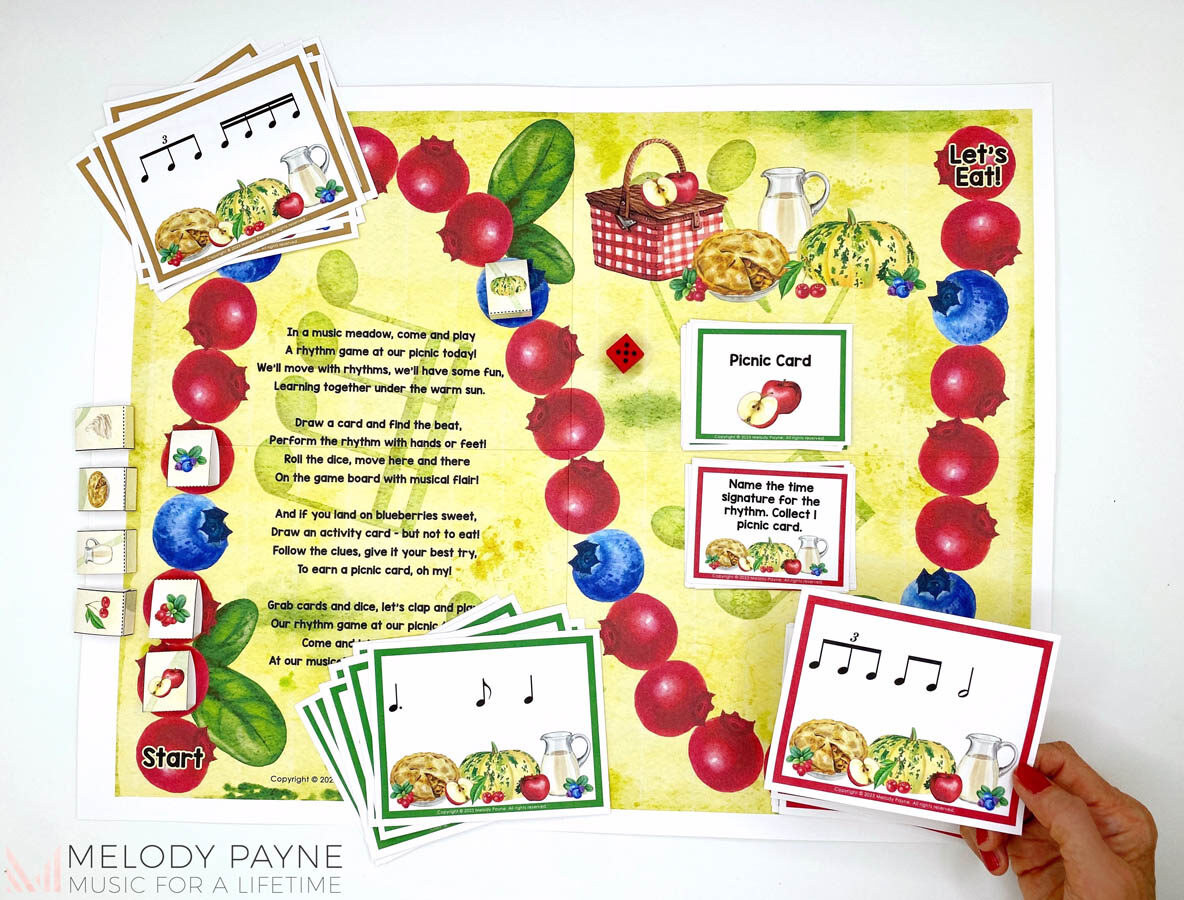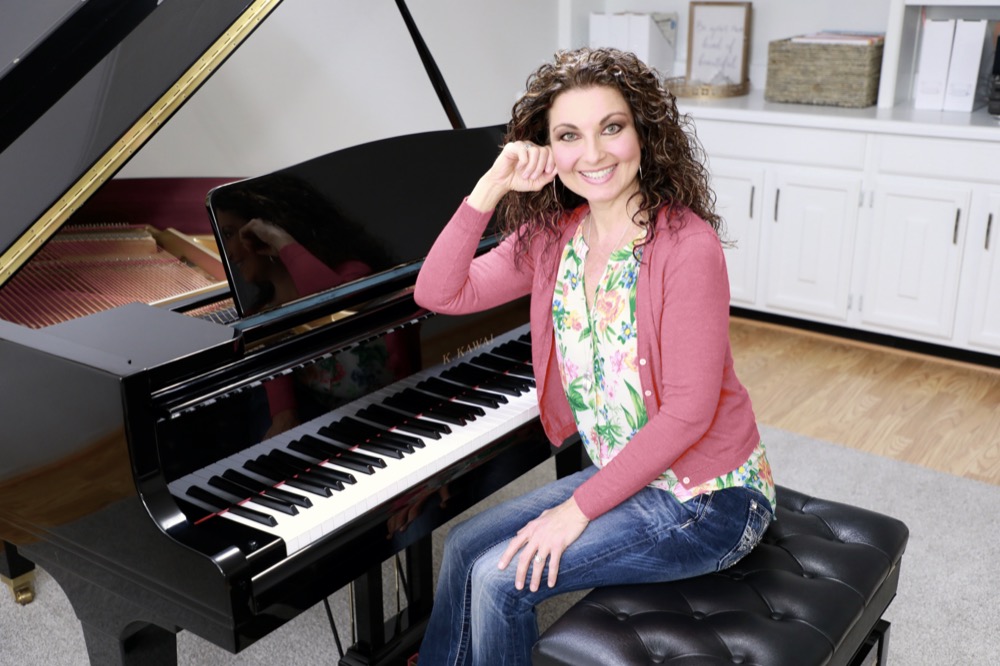The Best Rhythm Game for Teaching Rhythm Skills
This post may contain affiliate links. If you purchase something through an affiliate link, I will receive a small commission at no cost to you. For more information, read the disclosure statement here.

I’m very excited to be blogging about the Picnic Rhythm Game because this was a requested resource.
I was looking for a rhythm game that utilized fun rhythm syllables that would stick in my students’ memory, and an alternative to using Kodaly or Gordon rhythm syllables.
Dr. Melody Payne gave me a peek into the creation process, and I was able to provide input and feedback on the music rhythm game as it was being refined.
One of the food syllable ideas I submitted was an idea that my student and her mother came up with!
The final product that Dr. Payne created truly exceeded my expectations.
It turned out to be a very thorough and adaptable music rhythm game that works with complete beginners through early intermediate piano students of all ages.
My students have been playing this music rhythm game for the past few weeks.
Whenever parents come in, they smile because they can see the value in what we are striving for. And they like seeing their children enjoying the learning process.
I’m excited to share 3 reasons why I think your students will enjoy this music rhythm game too.

If you’re looking for a preschool rhythm game, then read our blog post, Preschool Rhythm Activity Cards for Engaging Piano Lessons here.
1. It’s a Fun and Memorable Rhythm Game for Piano Lessons
The impetus for wanting a music rhythm game like this had to do with several piano students who would clam up when asked to chant Kodaly rhythm syllables, clap/count, or even just clap rhythms while chanting Kodaly rhythm syllables silently.
Fast forward to the time I was road-testing this music rhythm game: those same students were eager to clap and chant their “picnic” rhythm syllables.
This was a nice reminder that sometimes there’s the academic way of doing things, and then there’s the reality of what works right in front of you.
My students’ eyes lit up while they were engaged with the rhythm cards, and there was no hesitation or fear of making mistakes as they took a stab at new rhythms.
The fun and memorable aspects of the music rhythm game go hand in hand, and my students now better recognize rhythms in their music since starting to play this game.
It might take a while for a brand new beginner to remember what syllable goes with what rhythmic value, but it would be the same process even if you were teaching a different system.
2. This Picnic Music Rhythm Game for Piano Lessons Doesn’t Get Old
When I pulled out the music rhythm game on week 3, my students were just as excited as the first week when I introduced the game.
Also, the cheering and level of excitement when I brought out this music rhythm game has been on a different level compared to other games.
Fun fact: A younger student of mine was waiting for his lesson, saw us playing this game, and insisted on playing it during his lesson too.
Even though he was brand new-ish to lessons, he was able to play the music rhythm game and had a lot of fun doing so. (I only used cards with quarter, 8ths, and half notes!)
He’s been asking for this game every week now!
3. It’s a Thorough Music Rhythm Game for Piano Lessons that Students Can Grow Into
The music rhythm game for piano lessons is so versatile that it can be played with complete beginners all the way through early intermediate students by adapting which cards you use.
It’s fun without being babyish so it will appeal to a variety of ages.
Here are key aspects of the game I enjoy:
- Covers a variety of note values: quarter notes, half notes, 8th notes, 16th notes, triplets, and dotted rhythms
- A separate deck of cards for each meter: 2/4, 3/4, 4/4
- Rhythm cards increase in level of difficulty as you get further along in the deck (useful for tailoring it to individual students’ needs)
- The game board elevates the experience of playing the game: students can land on a blueberry spot to perform challenges and earn picnic cards.
- Being able to print a 17×22-inch full-sized game board at home definitely helps make it look and feel like a real board game.
With this music rhythm game, I was hoping for an appealing and adaptable one-stop shop music rhythm game that would cover rhythms that a beginner through an early intermediate student would need to know.
Ideally students would learn something every time they played the music rhythm game, and mastering the game should be a long-term goal so I wouldn’t have to keep searching for new rhythm games as students advanced into the late beginner and early intermediate levels.

Ideas for Different Phases of the Music Rhythm Game for Piano Lessons:
Phase 1 of the Music Rhythm Game:
- In the first few weeks, students are familiarizing themselves with matching the rhythm syllable to the note. Have the food cards available for easy reference.
- Since there are 3 separate decks (2/4, 3/4, 4/4-time signatures), I opted to start with the time signature they are most familiar with: 4/4, and only used this deck for the first few weeks. I partially did this to make it easier on myself, so that I can print and assemble elements of the game on an as-needed basis.
- Pro tip: Print the game board and cards onto bright white card stock and laminate if you like for a vibrant and long-lasting game.
- I did not yet introduce the second half of the 4/4 deck that includes dotted rhythms (or the corresponding food rhythms) since the difficulty level within the first half of the deck was appropriate for the time being.
- To capitalize on their enthusiasm and to avoid too much nitpicking on my part, I allowed students to pause between syllables as needed.
- Optional: Once students master the simple rhythms (without dotted rhythms), incorporate the metronome for an added challenge prior to introducing the second half of the deck.
- I did not use time signature cards yet.

Phase 2 of the Music Rhythm Game:
- Since the second half of each deck includes the most difficult rhythms, a good goal might be to cover the first half of all 3 decks.
- Once you have introduced all 3 different meters, students might be tasked with putting the correct time signature in front of the rhythm card(s) they are performing.

Phase 3 of the Music Rhythm Game:
- Once students can perform all cards from all decks, incorporate the metronome if you haven’t already (starting with a moderate tempo). You might add an extra challenge (at the appropriate time) where a student can earn a picnic card if they perform 2, 3, or 4 rhythm cards per turn.
- Incorporate the composition activity or adapt it for late beginner/early intermediate students by using staff paper, and having students create 8 bar melodies based on rhythm cards of their choosing.
- Mix up the decks so that students get a different meter at each turn, and have the students utilize the time signature cards.
- Watch Dr. Payne’s improvisation video to learn ideas about incorporating improvisation into the game!

I’m so excited to continue using this music rhythm game throughout the year (and beyond) because I know my students will experience so much growth and fun throughout the process!
Grab Picnic Rhythm Game today if you are looking for a one-stop shop music rhythm game that utilizes accessible rhythm syllables for your beginner through early intermediate students of all ages.
Get the Picnic Rhythm Cards & Activities Game here.
What are your best rhythm-teaching tips?
Have you done special rhythm challenges in your studio? How have your students best grasped rhythms? We’d love to hear! Join the conversation by commenting below.
More creative piano teaching blog posts you’ll love…
Don't miss out!
Follow on Facebook and Instagram, join the best Facebook group for piano teachers, and subscribe to the newsletter to get helpful teaching tips, resources, and tutorials delivered straight to your inbox every week.
Michelle Madasamy
Michelle Madasamy
Welcome!

Hi! I’m Melody Payne, a pianist and piano teacher, educational resource author, a fun-loving wife to the most wonderful and talented hubby I could ask for, and a lifelong learner who loves to share. I want to make your life as a music teacher easier by writing and sharing helpful and relevant music teaching articles, and by creating educational resources with your very own students in mind. If you are a parent who wants to enroll your child in piano lessons, I’d love for us to get started building those skills that can give your child a lifetime of musical enjoyment!

